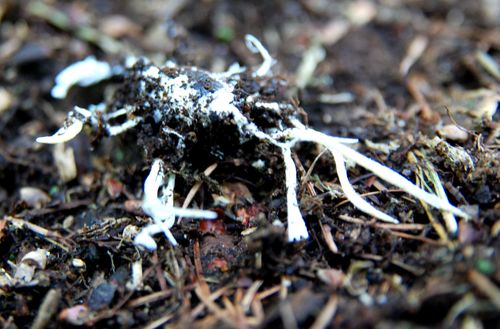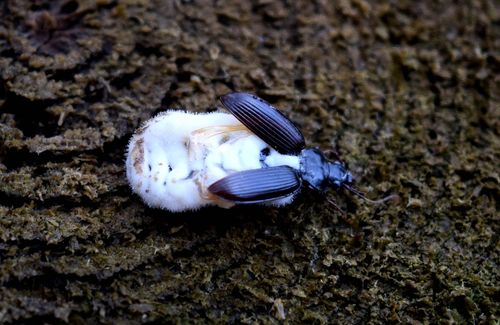Taxonomy, clavicipitaceous fungi and the juggler of molecules
P.F. Whitehead.
Moor Leys, Little Comberton, Pershore, Worcestershire WR10 3EH Email: paul@thewhiteheads.eu
Introduction
For many of us concerned with the systematic position of organisms their phyletic placement within recognised taxa are the hooks on which the relationships of life forms are hung. In recent times the application of mitochondrial DNA analyses has begun to revolutionise our understanding of these relationships. To some extent thereby hangs a problem, or more correctly, problems, because the light provided by molecular laboratory studies often casts shadows over our wider perception.
The biological assessor, the student of faunistics, or the writer of identification handbooks will always be hindered if species can only be recognised precisely by sophisticated laboratory techniques. The problem might be contrasted in this way: while biologists race to describe unknown life forms faced with imminent extinction molecular scientists construct or deconstruct clades and determine phyletic exactness in the wider context of all life. Which, might one argue if the question is not unduly specious, is the more relevant? An illustration using fungi may or may not help to provide an answer.
Nomenclature, taxonomy and entomogenous fungi
Taxonomically valid species require a scientific published description, a valid binomial and an available type specimen designated to support the description. This may be a holotype, a subsequently designated lectotype together with an accompanying series of paratypes. Usually, but not always, a species is the product of embryonic fertilisation. Exceptions to this include parthenogenesis e.g. in some weevils where an imago is the result of an unfertilised embryo, and amongst plants where the same process creates rafts of ‘microspecies’ through apomixis. Valid binomials have traditionally been applied to all of these variations.
01. Cordyceps sp. (? militaris (L., Fr.) Fr., 1818) (Hypocreales:Cordycipitaceae) on noctuid moth pupa Pwll Mawr Wood, Wye Valley VC35 SO51 135 m a.s.l. 13 August 2013 © P.F. Whitehead.
Nomenclatural issues from the Kingdom of fungi have perplexed mycologists (and me!) for decades. Historically, Article 59 of the International Code of Botanical Nomenclature permitted mycologists to give asexually reproducing fungi binomials distinct from those applied to their sexual states; this practice was discontinued only as recently as 2013. Many fungi from a range of taxonomic orders reproduce both sexually and asexually. When mycologists applied binomials to asexual forms, which they termed anamorphs, they were often unaware of the sexual states of these species, which they termed teleomorphs, or as we shall see, even where they existed. The 2013 ruling meant that one fungus cannot bear two names and that the name of the sexual stage should have precedence.
For one group of fungi, the entomogenous ascomycotine Hypocreales, this will inevitably result in a significant revision of established texts. To some extent this process has already begun (Sung et al., 2007). A key entomogenous fungal genus is Cordyceps Fries which produces as its sexual stage characteristic elongate often clavate stromata (01) eventually with fertile expanded heads (Samson, Evans and Latgé, 1988). A species of special regional importance is Harposporium bredonense Evans & Whitehead, 2005 known globally only from Bredon Hill and Tiddesley Wood, Pershore, where its host in both cases is arboreal cerambycid beetles.
A significant problem of applying binomials to anamorphs of the more than 400 species of Cordyceps can be understood when it is recognised that they include at least ten genera thereby making for a large number of potentially ‘synthetic’ relationships. What this boils down to is that taxonomy is presently waiting on the results of informed molecular studies but more especially that field workers are waiting on how molecular scientists might translate their work into helpful results. Sung et al. (2007) succeeded in this regard by indicating that the structure, colour and texture of the stromata are highly significant in establishing phylogenies in some entomogenous fungi.
02. Cordyceps bassiana Li, Li, Huang & Fan, 2001 in its anamorphic state ‘Beauveria bassiana (Bals.-Criv.) Vuill.’ (Hypocreales:Cordycipitaceae) on Nebria brevicollis (F., 1792) (Coleoptera:Carabidae) Stanway woods complex, Gloucestershire VC33 SP03 184 m a.s.l. 15 November 2014. Further molecular studies are likely to require that this determination be revised. © P.F. Whitehead.
For the moment the fungus illustrated here in 01 can only be determined to Cordyceps sp. It may well be the same species as the anamorphic Paecilomyces farinosus (Holmsk.) Fr. which is now most usually placed in Isaria! This is the species that Pacioni and Frizzi (1978) demonstrated was the anamorph of Cordyceps memorabilis (Ces.) Sacc., 1879. However, whilst 01 shows well-developed stromata there appear to be no fertile coloured stromatic heads; on this basis it could belong to Cordyceps militaris (L., Fr.) Fr., 1818 and this may well be its true identity. As molecular studies progress images such as these are likely to become easier to assign.
As a final confirmation of the revolutionary findings of molecular systematics in this group one may cite the well-known entomogenous fungus Beauveria bassiana (Bals.-Criv.) Vuill. (02). Ignoring for the moment whether or not this is a species or a species-complex it is presently held to be the anamorph of Cordyceps bassiana Li, Li, Huang & Fan, 2001, the teleomorphic stage which is apparently up to now only known from the East Palaearctic Region.
Conclusion
Continuing molecular research on this most challenging group of organisms will hopefully bring further clarity and resolution of taxonomic difficulties, especially given the enormous geographical ranges of some species. If published findings can be applied to field work my question (vide supra) will to some extent have been answered.
References
Pacioni, G. & Frizzi, G. 1978. Paecilomyces farinosus the conidial state of Cordyceps memorabilis. Canadian Journal of Botany 56:391-394.
Samson, R.A., Evans, H.C. & Latgé, J.-P. 1988. Atlas of entomopathogenic fungi. 187 pp. Springer-Verlag.
Sung, G.-H., Hywel-Jones, N-L., Sung, J.-M., Luangsa-ard, J.J., Shrestha, B. & Spatafora, J.W. 2007. Phylogenetic classification of Cordyceps and the clavicipitaceous fungi. Studies in mycology 57:5-59.
Whitehead, P.F. & Evans, H.C. 2005. Entomogenous fungi of arboreal Coleoptera from Worcestershire England including the new species Harposporium bredonense. Mycological Progress 4:91-99.
Whitehead, P.F. 2008. A second record of the entomogenous fungus Harposporium bredonense Evans & Whitehead, 2005 (Clavicipitales). Entomologist’s Monthly Magazine 144:162.
Images
01. Cordyceps sp on noctuid moth pupa. Paul Whitehead.
02. Cordyceps bassiana on Nebria brevicollis. Paul Whitehead.

